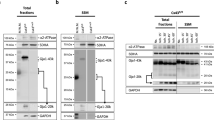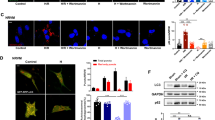Abstract
Introduction
REM sleep deprivation (SD) decreases tolerance of the rat heart to ischemia-reperfusion (IR) injury; the underlying mechanisms, however, are unknown. This study aimed at determining whether changes in iNOS, Bax, and Bcl-2 gene expression are involved in this detrimental effect.
Method
SD was induced by flowerpot technique for a period of 4 days. This method is simple and able to induce sleep fragmentation which occurs as one of the sleep disorder symptoms in clinical conditions. The hearts of control and SD rats were perfused in Langendorff apparatus and subjected to 30 min ischemia, followed by 90 min reperfusion. The hemodynamic parameters (left ventricular developed pressure (LVDP), and ± dp/dt), NOx (nitrite + nitrate) level, infarct size, and mRNA expression of iNOS, Bax, and Bcl-2 were measured after IR.
Results
SD rats had lower recovery of post-ischemic LVDP (32.8 ± 2.5 vs. 51.5 ± 2.1 mmHg; P < 0.05), + dp/dt (1555 ± 66 vs. 1119.5 ± 87 mmHg/s; P < 0.05) and − dp/dt (1437 ± 65 vs. 888 ± 162 mmHg/s; P < 0.05). SD rats also had higher NOx levels (41.4 ± 3.1 vs. 22.4 ± 3.6 μmol/L; P < 0.05) and infarct size (64.3 ± 2.3 vs. 38.3 ± 1.6%; P < 0.05) after IR, which along with LVDP, ± dp/dt restored to near normal status in the presence of aminoguanidine, a selective iNOS inhibitor. Following IR, expression of iNOS and Bax increased and Bcl-2 decreased (502, 372, and 54%, respectively) in SD rats; whereas in the presence of aminoguanidine, expression of iNOS and Bax significantly decreased and Bcl-2 increased (165, 168, and 19%, respectively).
Conclusion
Higher expression of iNOS and subsequent increase in apoptosis in the hearts after IR may contribute to less tolerance to myocardial IR injury in SD rats.



Similar content being viewed by others
References
Hausenloy DJ (2009) Signalling pathways in ischaemic postconditioning. Thromb Haemost 101(4):626–634
Silvestri P et al (2009) MicroRNAs and ischemic heart disease: towards a better comprehension of pathogenesis, new diagnostic tools and new therapeutic targets. Recent Pat Cardiovasc Drug Discov 4(2):109–118
Yousefzadeh N, Jeddi S, Alipour MR (2016) Effect of fetal hypothyroidism on cardiac myosin heavy chain expression in male rats. Arq Bras Cardiol 107(2):147–153
Yousefzadeh N, et al (2017) Effect of fetal hypothyroidism on MyomiR network and its target gene expression profiles in heart of offspring rats. Mol Cell Biochem
Jeddi S et al (2016) The effect of sleep deprivation on cardiac function and tolerance to ischemia-reperfusion injury in male rats. Arq Bras Cardiol 106(1):41–48
Mullington JM et al (2009) Cardiovascular, inflammatory, and metabolic consequences of sleep deprivation. Prog Cardiovasc Dis 51(4):294–302
Cappuccio FP et al (2011) Sleep duration predicts cardiovascular outcomes: a systematic review and meta-analysis of prospective studies. Eur Heart J 32(12):1484–1492
Ferrie JE et al (2011) Sleep epidemiology—a rapidly growing field. Int J Epidemiol 40(6):1431–1437
Buxton OM, Marcelli E (2010) Short and long sleep are positively associated with obesity, diabetes, hypertension, and cardiovascular disease among adults in the United States. Soc Sci Med 71(5):1027–1036
Jeddi S, Zaman J, Ghasemi A (2016) Effect of fetal hypothyroidism on tolerance to ischemia-reperfusion injury in aged male rats: role of nitric oxide. Nitric Oxide 55-56:82–90
Jeddi S et al (2016) Effects of nitrate intake on myocardial ischemia-reperfusion injury in diabetic rats. Arq Bras Cardiol 107(4):339–347
Ghasemi A, Jeddi S (2017) Anti-obesity and anti-diabetic effects of nitrate and nitrite. Nitric Oxide
Li D et al (2006) Inhibition of iNOS protects the aging heart against beta-adrenergic receptor stimulation-induced cardiac dysfunction and myocardial ischemic injury. J Surg Res 131(1):64–72
Liu P et al (2002) Age-related difference in myocardial function and inflammation in a rat model of myocardial ischemia-reperfusion. Cardiovasc Res 56(3):443–453
Andreadou I et al (2015) The role of gasotransmitters NO, H2S and CO in myocardial ischaemia/reperfusion injury and cardioprotection by preconditioning, postconditioning and remote conditioning. Br J Pharmacol 172(6):1587–1606
Razavi HM, Hamilton JA, Feng Q (2005) Modulation of apoptosis by nitric oxide: implications in myocardial ischemia and heart failure. Pharmacol Ther 106(2):147–162
Zaman J, Jeddi S, Ghasemi A (2014) The effects of ischemic postconditioning on myocardial function and nitric oxide metabolites following ischemia-reperfusion in hyperthyroid rats. Korean J Physiol Pharmacol 18(6):481–487
Toth LA, Bhargava P (2013) Animal models of sleep disorders. Comp Med 63(2):91–104
Alkadhi K et al (2013) Neurobiological consequences of sleep deprivation. Curr Neuropharmacol 11(3):231–249
Machado RB et al (2004) Sleep deprivation induced by the modified multiple platform technique: quantification of sleep loss and recovery. Brain Res 1004(1–2):45–51
Ghanbari M et al (2015) The effect of maternal hypothyroidism on cardiac function and tolerance to ischemia-reperfusion injury in offspring male and female rats. J Endocrinol Investig 38(8):915–922
Ding HL et al (2005) Inducible nitric oxide synthase contributes to intermittent hypoxia against ischemia/reperfusion injury. Acta Pharmacol Sin 26(3):315–322
Belaidi E et al (2012) Delayed myocardial preconditioning induced by cobalt chloride in the rat: HIF-1alpha and iNOS involvement. Fundam Clin Pharmacol 26(4):454–462
Jeddi S et al (2016) Involvement of inducible nitric oxide synthase in the loss of cardioprotection by ischemic postconditioning in hypothyroid rats. Gene 580(2):169–176
Zaman J et al (2015) Ischemic postconditioning provides cardioprotective and antiapoptotic effects against ischemia-reperfusion injury through iNOS inhibition in hyperthyroid rats. Gene 570(2):185–190
Jeddi S, Zaman J, Ghasemi A (2015) Effects of ischemic postconditioning on the hemodynamic parameters and heart nitric oxide levels of hypothyroid rats. Arq Bras Cardiol 104(2):136–143
Carvalho RS et al (2014) Paradoxical sleep deprivation increases mortality in myocardial infarcted rats. Sleep Biol Rhythms 12(3):216–219
Almeida FR et al (2014) Cardiovascular function alterations induced by acute paradoxical sleep deprivation in rats. Clin Exp Hypertens 36(8):567–571
Kato M et al (2000) Effects of sleep deprivation on neural circulatory control. Hypertension 35(5):1173–1175
Ogawa Y et al (2003) Total sleep deprivation elevates blood pressure through arterial baroreflex resetting: a study with microneurographic technique. Sleep 26(8):986–989
Andersen ML et al (2005) Endocrinological and catecholaminergic alterations during sleep deprivation and recovery in male rats. J Sleep Res 14(1):83–90
Sgoifo A et al (2006) Effects of sleep deprivation on cardiac autonomic and pituitary-adrenocortical stress reactivity in rats. Psychoneuroendocrinology 31(2):197–208
Wildhirt SM et al (1997) Selective modulation of inducible nitric oxide synthase isozyme in myocardial infarction. Circulation 96(5):1616–1623
Badalzadeh R et al (2012) The additive effects of ischemic postconditioning and cyclosporine-A on nitric oxide activity and functions of diabetic myocardium injured by ischemia/reperfusion. J Cardiovasc Pharmacol Ther 17(2):181–189
Segal J et al (1996) Acute effect of thyroid hormone in the rat heart: role of calcium. J Endocrinol 149(1):73–80
Moens AL et al (2005) Myocardial ischemia/reperfusion-injury, a clinical view on a complex pathophysiological process. Int J Cardiol 100(2):179–190
Sun Y et al (2009) Deletion of inducible nitric oxide synthase provides cardioprotection in mice with 2-kidney, 1-clip hypertension. Hypertension 53(1):49–56
Di Napoli P et al (2001) Simvastatin reduces reperfusion injury by modulating nitric oxide synthase expression: an ex vivo study in isolated working rat hearts. Cardiovasc Res 51(2):283–293
Badalzadeh R, Mokhtari B, Yavari R (2015) Contribution of apoptosis in myocardial reperfusion injury and loss of cardioprotection in diabetes mellitus. J Physiol Sci 65(3):201–215
Villafuerte G et al (2015) Sleep deprivation and oxidative stress in animal models: a systematic review. Oxidative Med Cell Longev 2015:234952
Mullington JM et al (2010) Sleep loss and inflammation. Best Pract Res Clin Endocrinol Metab 24(5):775–784
Sam F et al (2001) Mice lacking inducible nitric oxide synthase have improved left ventricular contractile function and reduced apoptotic cell death late after myocardial infarction. Circ Res 89(4):351–356
Ertl G, Frantz S (2005) Healing after myocardial infarction. Cardiovasc Res 66(1):22–32
Saito T et al (2002) Inhibition of NOS II prevents cardiac dysfunction in myocardial infarction and congestive heart failure. Am J Physiol Heart Circ Physiol 283(1):H339–H345
Author information
Authors and Affiliations
Corresponding author
Ethics declarations
Ethical approval
This study was approved by the local ethics committee of the Research Institute for Educational Sciences; all procedures were performed in accordance with the National Institutes of Health Guide for the Care and Use of Laboratory Animals.
Rights and permissions
About this article
Cite this article
Jeddi, S., Ghasemi, A., Asgari, A. et al. Role of inducible nitric oxide synthase in myocardial ischemia-reperfusion injury in sleep-deprived rats. Sleep Breath 22, 353–359 (2018). https://doi.org/10.1007/s11325-017-1573-7
Received:
Revised:
Accepted:
Published:
Issue Date:
DOI: https://doi.org/10.1007/s11325-017-1573-7




